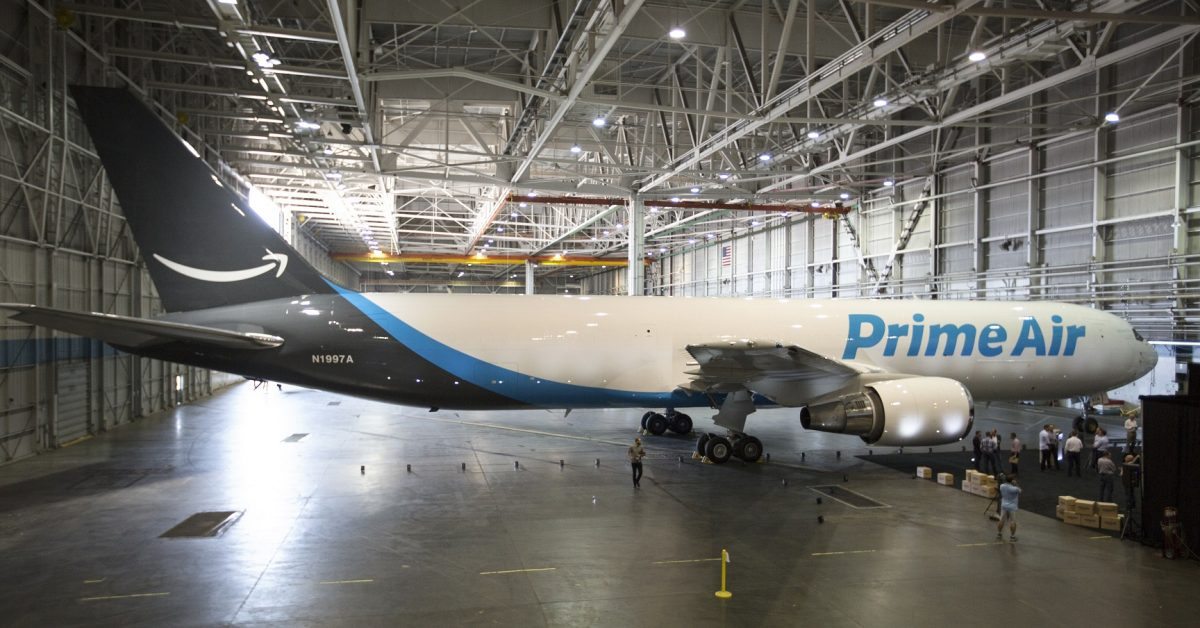Kentucky’s Governor recently announced Amazon’s new project to build a $1.49 billion Prime Air hub at Cincinnati/Northern Kentucky International Airport (CVG) in Hebron. If this new investment can seems huge, it is also relative as it represents just a little bit more than 1% of the e-commerce giant turnover (ig. Jeff Bezos’ firm earned $107 billions in 2015, 2016 profit is still unknown as for now). The new hub will serve for its fleet of Prime Air planes.
For the record, the Seattle firm launched its very own air fleet, Amazon Prime Air last year. Indeed the e-commerce giant chose to possess its own cargo airplanes, principally dedicated to support orders from US subscribers of the Prime service with fast and free shipping which enables the reception of a parcel within 24 or 48 hours. Amazon’s air fleet consists of 40 Boeing 767-300 leased from Air Transport Services Group (ATSG) and Atlas Air. For now, only 16 of those Prime Air cargo planes are in activity, with more to come over time. The upcoming hub will be designed to welcome minimum the entire fleet, which should be fully operational within 2 years.
Amazon’s Prime Air hub project will reinforces the company’s presence of almost 20 years in Kentucky. The team of already 10,000 full-time employers dispersed within 11 fulfillment centers will welcome 2,700 new colleagues. Senior vice pres. of Amazon’s worldwide operations, Dave Clark, explained that Kentucky is considered somehow ideal location. It is located at the center of the US territory and already possess a considerable shipping and logistics industry.
Constant with its very own way of approaching the world we live in, Amazon is about to embark on this disruptive project and will likely revolutionize once more the relationship it maintains with its customers, becoming even closer to them.
Is Amazon’s project feasible?
Amazon’s Prime Air hub project is ambitious. As everything seems to be planned, one question leave up in the air though: whether Amazon’s partners will be able to deal with the expansion or not. Indeed, Amazon.com Inc. actually works with subsidiaries of ATSG, but their pilots are currently in a labor strife concerning pay & working conditions since last year. Making it quite complicated to assure the company will be able to fulfill its growing obligations towards Amazon.
According to Cincinnati/Northern Kentucky director, Amazon plans to send 200 flights a day from its new hub. Thus, in order to comply with Amazon’s growing demand for faster parcels shipment, the delivery company will have to speed up its process. But with 15 planes currently flying for Amazon, 5 more to come, and a team declaring they are understaffed and forced to work on their time off, Amazon might be wondering who is going to operate its planes.
Will the e-commerce giant enter the carrier game?
As time goes on and the giant company expands even further, Amazon’s Prime Air hub development suggests another strategy could be in reflection. In fact, if the Prime Air test is conclusive, it might be willing to encroach competitor businesses like UPS, FedEx or DHL. And it could become one of their direct competition in the furture.
In order to grow in the transportation sector Amazon is not only developing its air infrastructures but it has also started to show interest in other means of transportation, for example sea and land routes. As the Wall Street Journal explained, Amazon has in fact transited about 150 containers from China only between Oct. 2016 and Jan. 2017. Its also keeping an eye on self-driving vehicles for more fuel efficient logistics. Indeed the firm has already filed a patent application in late 2015 and received the approval in Jan. 2017.
Finally, in order to show their customers they haven’t forgotten the long awaited drone delivery service, the e-commerce giant used its Superbowl 2017 ad time to communicate about it:
Doritos. Drones. Drama. The perfect recipe for the big game. #JustAsk Alexa #SB51 pic.twitter.com/5sMvM5O6mU
— Amazon Echo (@amazonecho) 6 février 2017
With so much transport development, do you think Amazon is going toward the right direction, or is it about to bite off more than it can actually chew?





